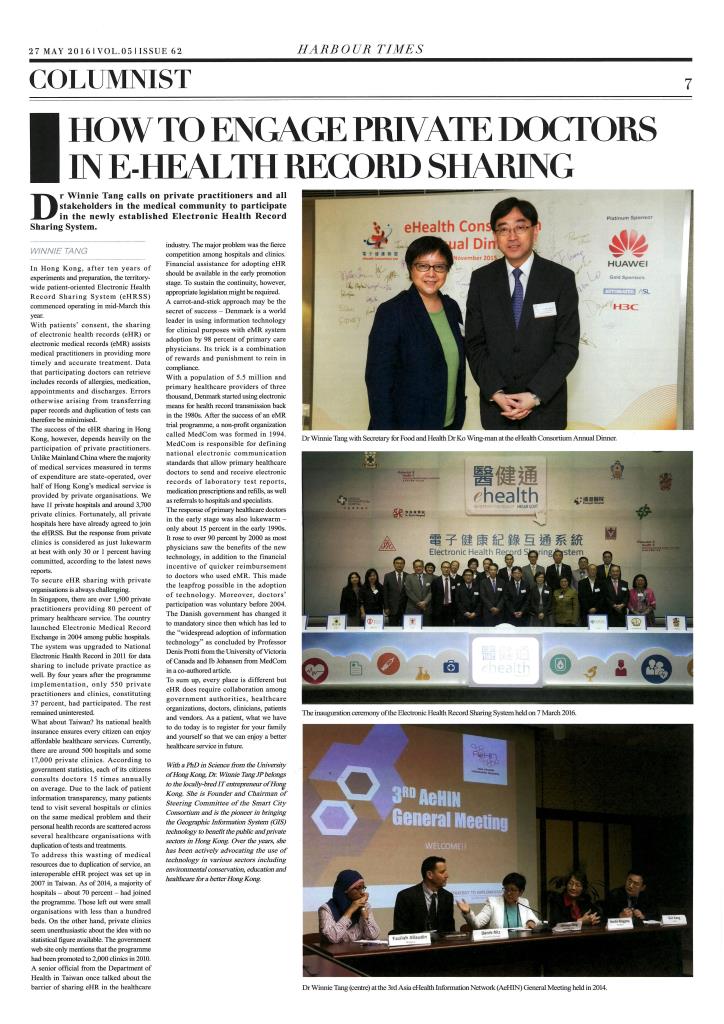網上版請按此

How to engage private doctors in e-health record sharing
In Hong Kong, after ten years of experiments and preparation, the territory-wide patient-oriented Electronic Health Record Sharing System (eHRSS) commenced operating in mid March this year.
With patients’ consent, the sharing of electronic health record (eHR) or electronic medical record (eMR) assists medical practitioners in providing more timely and accurate treatment. Data that participating doctors can retrieve includes allergies, medication, appointments records and discharge summary, etc. Errors otherwise arising from transferring paper records and duplication of tests can therefore be minimized.
The success of the eHR sharing in Hong Kong, however, depends heavily on the participation of private practitioners. Unlike Mainland China where majority of medical services measured in terms of expenditure are state-operated, over half of Hong Kong’s medical service is provided by private organizations. We have 11 private hospitals and around 3,700 private clinics. Fortunately, all private hospitals here have already agreed to join the eHRSS. But the response from private clinics is considered as just lukewarm at best with only 30 or 1% having committed, according to the latest news reports.
To secure eHR sharing with private organizations is always challenging.
In Singapore, there are over 1,500 private practitioners providing 80% primary healthcare service. The country launched Electronic Medical Record Exchange in 2004 among public hospitals. The system was upgraded to National Electronic Health Record in 2011 for data sharing to include private practice as well. By four years after the programme implementation, only 550 private practitioners and clinics which constitutes 37% had participated. The rest of the two thirds remained uninterested.
What about Taiwan? Its national health insurance ensures every citizen can enjoy affordable healthcare services. Currently, there are around 500 hospitals and some 17,000 private clinics. According to the government statistics, each of its citizen consults doctors 15 times annually on average. Due to the lack of patient information transparency, many patients tend to visit several hospitals or clinics on the same medical problem and their personal health records are scattered across several healthcare organizations with duplication of tests and treatments.
To address this wasting of medical resources due to duplication of service, an interoperable eHR project had been set up in 2007 in Taiwan. As of 2014, a majority of hospitals – about 70% – had joined the programme. Those left out were the small organizations with less than a hundred beds. On the other hand, private clinics seem unenthusiastic about the idea with no statistical figure available. The government web site only mentions that the programme had been promoted to 2,000 clinics in 2010.
A senior official from the Department of Health in Taiwan once talked about the barrier of sharing eHR in healthcare industry. The major problem was the fierce competition among hospitals and clinics. Financial assistance for adopting eHR should be available in the early promotion stage. To sustain the continuity, however, appropriate legislation might be required.
A carrot-and-stick approach may be the secret of success – Denmark is a world leader in using the information technology for clinical purposes with eMR system adoption by 98% primary care physicians. Its trick is a combination of rewards and punishment to rein in compliance.
With a population of 5.5 million and primary healthcare providers of three thousand, Denmark started using electronic means for health record transmission back in the 1980s. After the success of a eMR trial programme, a non-profit organization called MedCom was formed in 1994. MedCom is responsible for defining national electronic communication standards that allow primary healthcare doctors to send and receive electronically records of laboratory test reports, medication prescriptions and refills, as well as referrals to hospitals and specialists.
The response of primary healthcare doctors in the early stage was also lukewarm – only about 15 percent in the early 1990s. It rose to over 90 percent by 2000 as most physicians saw the benefits of the new technology, in addition to financial incentive of quicker reimbursement to doctors who used eMR. This made the leapfrog possible in the adoption of technology. Moreover, the doctors’ participation was voluntary before 2004. The Danish government changed it to mandatory since then which led to the “widespread adoption of information technology” as concluded by Professor Denis Protti from the University of Victoria of Canada and Ib Johansen from MedCom in a co-authored article.
To sum up, every place is different but eHR does require collaboration among government authorities, healthcare organizations, doctors, clinicians, patients and vendors. As a patient, what we have to do today is to register for your family and yourself so that we can enjoy a better healthcare service in future.
Dr. Winnie Tang
With a PhD in Science from the University of Hong Kong, Dr. Winnie Tang JP belongs to the locally-bred IT entrepreneur of Hong Kong. She is Founder and Chairman of Steering Committee of the Smart City Consortium and is the pioneer in bringing the Geographic Information System (GIS) technology to benefit the public and private sectors in Hong Kong. Over the years, she has been actively advocating the use of technology in various sectors including environmental conservation, education and healthcare for a better Hong Kong.